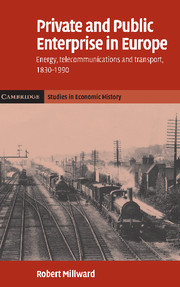Book contents
- Frontmatter
- Contents
- List of figures
- List of tables
- Preface
- Glossary and abbreviations
- Map: The European economy in 1914
- Part I Introduction
- Part II The Construction of the New European Infrastructure c. 1830–1914
- Part III Nations and Networks c. 1914–1945
- Part IV State Enterprise c. 1945–1990
- Part V Conclusions
- 15 The road to deregulation and privatisation?
- Appendix: Infrastructure service levels and public ownership c. 1910: a statistical analysis
- Bibliography
- Index
15 - The road to deregulation and privatisation?
Published online by Cambridge University Press: 14 July 2009
- Frontmatter
- Contents
- List of figures
- List of tables
- Preface
- Glossary and abbreviations
- Map: The European economy in 1914
- Part I Introduction
- Part II The Construction of the New European Infrastructure c. 1830–1914
- Part III Nations and Networks c. 1914–1945
- Part IV State Enterprise c. 1945–1990
- Part V Conclusions
- 15 The road to deregulation and privatisation?
- Appendix: Infrastructure service levels and public ownership c. 1910: a statistical analysis
- Bibliography
- Index
Summary
The end of the twentieth century witnessed a major institutional change in Europe, that of deregulation and privatisation. It is a huge topic with a vast literature and the analysis of its history has yet to be written. The aim in this conclusion is to draw on the research findings of this book to answer two questions. How far was the move to deregulation and privatisation prompted by economic and technological change? How far were the premises of deregulation and privatisation, as that process started in the 1980s, supported by the prior economic history of the infrastructure industries?
Although we await a comprehensive history of the incidence and timing of deregulation and privatisation, much has been written in support of the changes. Some has come from economic theory and has usually characterised regulatory bodies and especially public enterprises as inferior institutions, better replaced by competition and private enterprise. The analysis of property rights in public and private firms suggests weak incentive mechanisms in the former for monitoring managerial performance. Regulation of industry has been characterised by some economists as a process whereby the regulated firms come to dominate the scene and capture the regulator. Principal-agent theory sees asymmetries in the information between managers and owners, though this argument and the property rights argument leaves to empirical verification whether the problem is worse in large private joint stock companies than in public enterprises.
- Type
- Chapter
- Information
- Private and Public Enterprise in EuropeEnergy, Telecommunications and Transport, 1830–1990, pp. 287 - 299Publisher: Cambridge University PressPrint publication year: 2005

